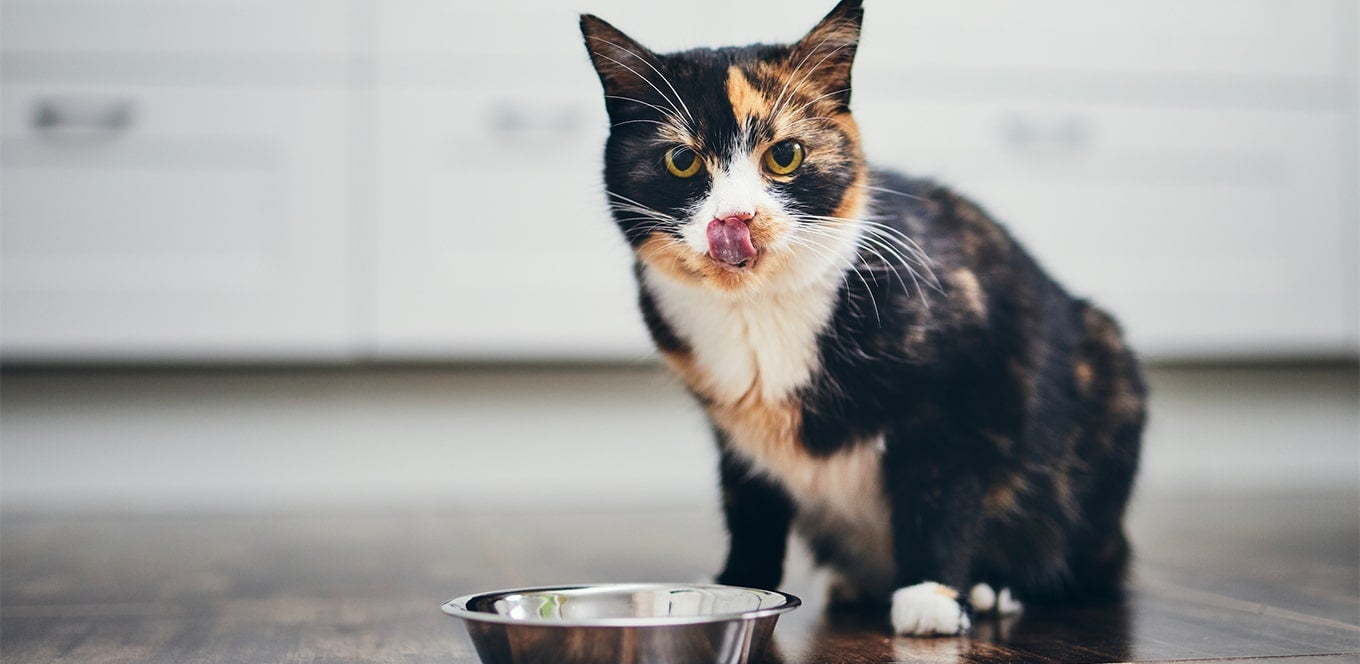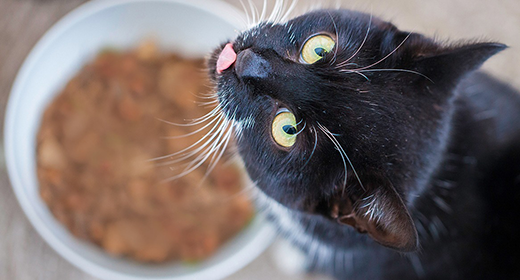

Knowing your cat needs a change in their diet is one thing, but knowing how to make that change is something else! Cats are creatures of habit, so it’s not uncommon for them to prefer their current food to anything new. Change disrupts their routine, which can impact their behavior and their digestion.
Thankfully, when the time has come to change your cat’s diet, a little planning and preparation goes a long way toward making the transition easier for them (and for you).
The following tips will help you change your cat’s diet and successfully transition your cat to a new food:
There are lots of reasons to consider changing your cat’s food — maybe you have a new kitten to wean, a kitten who’s all grown up now or an adult cat entering their senior years. In addition to normal aging, advice from the vet is a common reason to change what you’re feeding your cat. Cats that need help reducing their weight or managing excessive hairballs might need the support of a new food designed with those needs in mind. Whatever your reason for changing your cat’s diet, make sure the new food will suit their needs. That way you only have to make the transition once, and can avoid upsetting their stomach by changing the routine too often.
Going slow is paws down the most successful way to ease your cat into a different diet. Start by mixing 25% new food with 75% familiar food. Slowly change the proportions over the next three days or so by gradually increasing the amount of new food and decreasing the amount of their familiar food. Think of it as a kind of weaning — at the end of this process, you should be feeding (and your cat should be eating) just the new food.
Your cat may choose to eat only the familiar food, or not eat at all … at first. But a healthy cat can miss meals for a day or two without causing health problems. Slow, steady and consistent wins this race!
How would you feel if someone tried to force you to eat strange food you didn’t want?
Aggressively dumping the new food into your cat’s dish and declaring that your cat had better eat it might inspire your cat to do anything besides eat!
A little gentleness in your approach goes a long way. Try using a pleasant tone of voice and encouraging your cat to taste the new food. Even if they don’t go for it at first, a gentle approach still goes over much better than an aggressive one.
Cats train us as much as we train them. Giving in to their demands reinforces that their refusal to eat the new food is acceptable, which makes transitioning to the new diet even more challenging in the long run.
So don’t give up! Don’t be tempted to revert back to your cat’s familiar foods, and don’t give your cat treats or table scraps during the initial three-day period.
This is the toughest dietary transition of them all, but there are a few ways to make the process easier. If your cat resists eating dry food for more than a few meals, try mixing a little warm water with it and maybe even warming the moistened food in the microwave for a few seconds.
If you mix dry food with water, remember to discard any uneaten leftovers after 20 minutes to prevent spoilage. (The same rule applies for wet food.) After your cat is used to the moistened dry food, you can gradually transition to serving the same food dry.
Changing your cat’s diet is sometimes necessary to help them live a happy, healthy life. The process of switching what, how or how often you feed your cat can be a little bumpy, but you can do it! By going slowly, staying patient and encouraging, sticking to the plan and making the transition as easy as possible, you’ll be giving your cat what they need and helping them adjust as comfortably as possible.


Do you know what’s in your cat’s food? And more importantly, do you know how those nutrients affect your cat’s health, including their muscles, skin, coat and nails, digestion, bone growth and so much more?
As the old adage goes, “You are what you eat,” so it stands to reason that by feeding your cat high-quality ingredients, their overall health will be positively impacted.
So, what’s in your cat’s food? Simply put, cat food nutrients are divided into four subcategories: protein, carbohydrates, fats, and vitamins and minerals. Learn more about each of these — and how they can affect your cat’s health.
Protein is best known for supplying amino acids, or protein subunits, to build hair, skin, nails, muscles, tendons, ligaments and cartilage.
Common cat food protein sources include meat, chicken, fish and some plant ingredients like corn gluten and soybean meal.
Cats and kittens are true carnivores and need essential amino acids. One of these, taurine, is not found in plant protein sources such as soybean meal — which means your cat needs a protein source from meat to stay healthy.
Carbohydrates (also known as starches [sugars]) and fibers provide energy and bulk, respectively. Plants and grains like wheat and corn are common carbohydrate sources.
Starches are made up of various types of sugar, such as glucose or fructose. Through digestion, cats can easily convert sugar into usable energy.
Fiber provides bulk to move food through your cat’s gastrointestinal tract, aiding in healthy digestion. Some types of fiber, such as vegetable gums and beet pulp, are fermented by bacteria in your cat’s intestines, creating short-chain fatty acids that serve as an important source of energy for the cells lining your cat’s intestinal tract.
Though it sometimes gets a bad rap, fat fulfills many vital bodily functions. Fat helps your cat maintain their body temperature, control inflammation and more. It is the primary form of stored energy in the body, providing twice as much energy as carbohydrates or proteins.
Fats are found in meats, fish and plant oils, such as flax and vegetable oils.
Fats also provide omega-6 and omega-3 fatty acids, which are important fat subunits. Omega-6 fatty acids are essential for skin and coat maintenance and proper membrane structure. Omega-3 fatty acids have also been shown to affect coat quality and skin health.
Nutrition tip: All IAMS™ dry foods contain an optimal ratio of omega-6 and omega-3 fatty acids to help support a healthy skin and coat.
Vitamins are responsible for promoting bone growth, blood clotting, energy production and oxidant protection in your cat.
Vitamins A, D, E and K require fat for absorption into the body, while vitamins such as the B-complex vitamins and vitamin C need water to be absorbed into the body.
Minerals provide skeletal support and aid in nerve transmission and muscle contractions.
Feeding your cat a high-quality, nutritionally complete diet is crucial. When choosing a cat food, make sure to read the label and look for optimal sources of protein, carbohydrates, fat, and vitamins and minerals. These building blocks will help ensure your cat lives a long and healthy life.